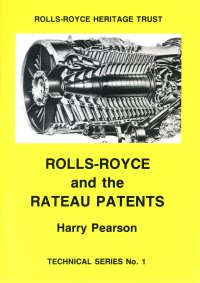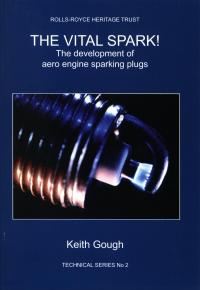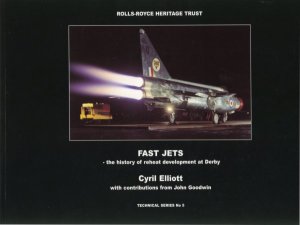Rolls-Royce Heritage Trust
Technical Series Reviews - Page 01
 |
Rolls-Royce and the Rateau Patents
by Harry Peterson
Softbound, 208mm x 148mm x 4mm, 43 pages
ISBN: 0-9511710-8-9
Rolls-Royce Heritage Trust
P.O. Box 31
Derby DE24 8BJ
England
Recommended Retail Price:
Please see Book List/Order Form
11 photographs/illustrations
|
Reviewed by Kimble D. McCutcheon
Rolls-Royce Heritage Trust Technical Series No. 1
In 1960 the French company Socété Rateau sued Rolls-Royce
in France and the United Kingdom for patent infringement, Rolls-Royce having
supplied engines with axial-flow compressors for French, British and American
aircraft. The two patents in question, filed in the name of M. René Anxionnaz in
1939, appeared at first inspection to apply to all jet propulsion using
axial-flow compressors.
Harry Pearson, a Rolls-Royce engineering manager, became
involved with the litigation when his careful reading of the patents exposed a
fundamental flaw — that they were based on a false claim. Pearson first had to
convince the Rolls-Royce solicitors, and then Rolls-Royce counsel that his views were correct
and that the patents should be attacked.
The Rateau patents showed remarkable foresight and
ingenuity for 1939, but they were based on the claim that a divergent inlet can
slow air velocity from flight speed to a speed that when compounded with
compressor blade tip speed, will remain below the speed of sound, and indeed can
be tuned to provide any predetermined velocity into the compressor. This claim
was proved false.
Pearson spent the next six years helping prepare technical
evidence for the cases and enlisting the testimony several expert witnesses,
including Sir Frank Whittle. Rateau had asked that in the event of successful
action that it be compensated for engines already built, that further
manufacture of offending engines should cease, and that Rolls-Royce should
deliver to them all parts, materials and complete engines. Clearly the stakes
were very high.
Rolls-Royce mounted several challenges to the validity of
the patents:
- Absence of inventive steps — though novel, the patents offered nothing really new.
- Inutility — the patents provided no recipe for a useful result.
- Ambiguity
- Lack of any fair basis for the claims.
- False suggestion — the air inlet did not produce the laimed effect.
- Insufficiency — there were no clear instructions for how engines could be constructed.
- Non-infringement — Rolls-Royce showed that blade-tip air velocity was subsonic under all reasonable conditions.
The French suit was tried first. To its surprise,
Rolls-Royce won.
The English suit started on 1 November 1966 and ended on 8
February 1967, the second longest patent suite up to that point. The judgment
was read on 26 April 1967. All of Rolls-Royce's challenges were upheld except for point
4. Rolls-Royce and Rateau reached an agreement to settle the costs, and the matter
ended.
By the time the suits were settled Anxionnaz had retired.
Pearson expressed sorrow that such ingenuity that was shown in the 1939 patents
could not have been put to better use.
This is the first book in the Rolls-Royce Heritage Trust
Technical Series. Though neither Pearson's narrative nor the patents (which are
reproduced in appendices) are highly technical, this work provides insight into
a very crucial point in Rolls-Royce gas turbine history.
 |
The Vital Spark!
the development of aero-engine sparking plugs
by Keith Gough
Softbound, 208mm x 148mm x 5mm, 59 pages
ISBN: 1-872922-02-3
Rolls-Royce Heritage Trust
P.O. Box 31
Derby DE24 8BJ
England
Recommended Retail Price:
Please see Book List/Order Form
62 photographs/illustrations
|
Reviewed by James A. King, Jr.
Rolls-Royce Heritage Trust Technical Series No. 2
One can learn much from Keith Gough's short book and
enjoy the process.
Aircraft piston engine enthusiasts who track increases in
engine performance tend to overlook the contributions of improved fuels and
sparking plugs. Gough covers the many problems and solutions required from the
very first plugs (French) through those for the highest-performing aircraft
engines — ones operating from maximum take-off and climb to extended slow cruise
on very long missions, at extreme boost, with fuels rich in tetraethyl lead. The
plugs discussed range from those marginally capable of surviving a single
mission to those operating quite satisfactorily untouched for the full engine
lifetime. Also covered are igniters for gas turbines.
The Vital Spark! , Number 2 in the Rolls-Royce
Heritage Trust Technical Series, is a most informative, interesting,
to-the-point, entertaining and enjoyable short read.
 |
The Performance of a
Supercharged Aero Engine
by Stanley Hooker, Harry Reed and Alan Yarker
Softbound, 208mm x 148mm x 6mm, 89 pages
ISBN: 978-1872922119
Rolls-Royce Heritage Trust
P.O. Box 31
Derby DE24 8BJ
England
Recommended Retail Price:
Please see Book List/Order Form
|
Critical Analysis by Robert Raymond
Rolls-Royce Heritage Trust Technical Series No. 3
Aside from laying the ground work for extremely impressive performance improvements, this effort by Rolls-Royce probably was a watershed in engine performance testing and analysis at that time. The report itself is remarkably clear and comprehensive for an internal company document. Reading reports in the engineering literature from that era and before, one senses that most engine development was not as insightful or far-sighted as their work. The adoption of dimensional analysis in supercharger testing illustrates this change.
The best that could be hoped for in the years leading up to World War II was a test where only one variable was changed at a time. Even in the work described here the analysis of the pumping loop was not thermodynamically rigorous but this oversight did not impact their results. They knew what needed to be varied and what held constant to make their technique work. Reading Schlaifer’s account of supercharger development in the 1930s gives one a sense of the crudeness that was prevalent throughout the industry. Some rigor was introduced by the NACA and their academic affiliates but the people that built and used the machines were mostly of the “cut and try” school of engineering.
This is not to denigrate these organizations, “cut and try” is an art form in itself, one in which Rolls-Royce also excelled and cannot be replaced by any analytical techniques in engine design and development even today.
 |
Flow Matching the Stages
of Axial Compressors
by Geoffrey Wilde
Softbound, 208mm x 148mm x 6mm, 77 pages
ISBN: 978-1872922140
Rolls-Royce Heritage Trust
P.O. Box 31
Derby DE24 8BJ
England
Recommended Retail Price:
Please see Book List/Order Form
44 figures
|
Reviewed by Charlie Cravens
Rolls-Royce Heritage Trust Technical Series No. 4
Upon
retirement from his senior engineering job at Rolls-Royce, author Geoffrey Wilde
became a visiting professor at the local university where he taught a course in
gas turbine design. In this course, students were required to complete the
aerodynamic design of an engine, to power a specific airplane, given its mission
requirements.
In the
design of such an engine, the compressor is crucial to its success, including
not only its performance but also what is called "handling". This refers to
starting and smooth response to throttle inputs. An improperly designed
compressor can result in failure to reach idle on starting, a stall or a surge
resulting from throttle movement.
The
blades and vanes in an axial compressor are airfoils, and as such are subject to
stall when the angle of incidence is too great. Stall is cleared by reducing the
angle of incidence; adding power is not an option within the engine, and in fact
the stall reduces pressure and airflow to the turbine and therefore reduces the
power available to the compressor.
If the
stall is a major event, it can cause compressor surge. When surge occurs, static
pressure in the front part of the compressor drops drastically, and an
instantaneous flow reversal will come from the downstream part of the engine.
Normal flow will be re-established; however, these events are violent and
startling.
Note: I
have seen high speed photos of a JT9D inlet taken during a surge event, and fire
from the combustor was clearly visible.
In an
axial compressor, the exit conditions from each airfoil row must match the
required inlet conditions of the row behind it. If there is a mismatch,
stall/surge may result.
Flow
area at the compressor exit is a function of the total flow required by the
turbine at its design point. Upstream geometry is designed to match, insofar as
possible. However, correct match cannot be achieved for all conditions (static
and transient), and optimal angle of incidence is achieved by use of movable
stator vanes.
Mr.
Wilde's book is based on a lesson plan used for his third year engineering
students, and describes the design of the R-R Avon engine's compressor.
Supplementary text describing some of his experiences at R-R is also provided.
The
result is a combination of interesting anecdotes and complex mathematics. The
mathematics deals with the vector analysis process used for the compressor
design. Although the Greek letters and fancy algebra may put the reader off, the
underlying process is actually rather simple. The key to understanding it is to
follow the vectors from stage to stage. You won't be able to design a
compressor, but you will understand how it is done.
Vector
analysis is also used to design turbines so you'll understand that too.
The
mathematics is necessary to determine temperatures, pressures, flow rates, and
efficiencies within the machine.
The
Avon dates from the 1950-1960 time frame, and employed a 12-stage compressor
with a 6.5:1 pressure ratio. Present day technology is represented by the
majority of civil turbofan engines which have pressure ratios of around 25:1,
with the GE90 operating at 40:1 and the R-R Trent at 50:1. No doubt further
improvement will be made.
It is
interesting to compare these numbers with typical compression ratios for modern
gasoline engines (9:1) and diesels (20:1).
Although design of a modern axial compressor is a far more complex process than
is described in this book, it is still based on a vector analysis.
To
summarize, this book is a worthwhile read for gearheads wanting to introduce
themselves to gas turbines. It illustrates the inherent complexity that
underlies the basic simplicity of the turbines. As technology has advanced,
however, the basic simplicity of the turbine engine has been mostly lost.
Gearheads should treat these engines with respect because of the kinetic energy
in the rotating parts. Failures tend to be spectacular, and can originate from
seemingly trivial issues.
 |
Fast Jets
the history of reheat development at Derby
by Cyril Elliott with contributions from John Goodwin
Softbound, 295mm x 210mm x 10mm, 148 pages
ISBN: 1-872922-20-1
Rolls-Royce Heritage Trust
P.O. Box 31
Derby DE24 8BJ
England
Recommended Retail Price:
Please see Book List/Order Form 142 illustrations
|
Reviewed by Graham White
Rolls-Royce Heritage Trust Technical Series No. 5
Fast Jets is a must read for folks who
enjoy high performance gas turbines. The mention of Derby in the title refers to
Derby England where Rolls-Royce aircraft engines have been developed since this
famous company got involved in aircraft engine development in 1914.
Consequently, this book only covers those reheat applications developed at this
location.
Like me, you probably
thought that afterburning, or reheat in English speak, was simply a question of
dumping a bunch of kerosene in the tail pipe of a jet. Think again. But it must
be added that even Lord Hives had the same though I had. Reheat development took
an inordinate amount of painful effort with almost the same number of problems
one would associate with engine development. Rolls-Royce entered the traitorous
field of gas turbines with the Derwent. It should be noted that all
Rolls-Royce gas turbines were and are, named after rivers, the Derwent being a
river situated in the midlands of England. Entering production in 1944, the
Derwent powered the Gloster Meteor. As always in military power
plants, too much power is just enough, in other words there is never enough. So
experiments were conducted with injecting fuel into the tail pipe. From these
beginning stages, Rolls-Royce went on to develop many reheat designs for
military applications. Of course, describing engine development has to go hand
in hand with aircraft development. By the jet age, more and more emphasis was
placed upon the power plant, how it was mounted and catering to all its needs.
This book is strictly for
those who enjoy the technical aspects of gas turbines, no wimps allowed.
Obviously, it is focused on reheat but don't be fooled into thinking there is
not much to it. To emphasize that point, this book should receive an honorable
mention in the Guinness Book of Records for having the largest fold-outs
of any book in print. Some of the fold out measure a staggering 60 inches wide -
and this just illustrates the reheat part of the engine. These massive
fold-outs, many of which are in color, need some studying to figure out what's
going on but after a while it's possible to understand the myriad schematics
illustrating fuel, hydraulics, compressed air, electrical systems, etc. Although
the illustrations fall in roughly the appropriate part of the text, it would
have been helpful to the reader if the illustrations had been referenced in the
text. Nevertheless, the photographs and illustrations are absolutely first
class.
Author Elliot goes through
the various developments that took place in Derby chronologically. He covers all
the gas turbine developments up to the Spey, used in the F4 Phantom. The
F4K Phantom has been described (not in this book I might add) as being
the slowest, heaviest and thirstiest of all the Phantoms. However, when
you look at the task facing Rolls-Royce engineers, it was a miracle it was even
pulled off. Even so, excellent insight is offered in the horrendous design and
engineering problems that had to be overcome in shoe-horning a Spey into
a Phantom airframe. After the Phantom episode, author Elliot was
reassigned and the text is picked up by John Goodwin who takes us through the
Adour
development phase and its numerous sub types powering the Jaguar.
A nice Appendix One lists
all the Rolls-Royce reheat engines including performance and applications.
Appendix Two, put together by Dave Birch who also edits the Rolls-Royce Heritage
Trust Derby Branch magazine, Archive, describes all the aircraft test
flown by Rolls-Royce in reheat development.
Again, this is a must-buy
for those interested in gas turbines. The fold-outs alone are well worth the
incredibly low price.




